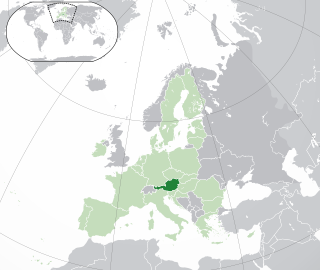
Johann Ludwig "Lutz" Graf Schwerin von Krosigk was a German senior government official who served as the minister of finance of Germany from 1932 to 1945 and de facto chancellor of Germany during May 1945.

The history of the Jews in Austria probably begins with the exodus of Jews from Judea under Roman occupation. There have been Jews in Austria since the 3rd century CE. Over the course of many centuries, the political status of the community rose and fell many times: during certain periods, the Jewish community prospered and enjoyed political equality, and during other periods it suffered pogroms, deportations to concentration camps and mass murder, and antisemitism. The Holocaust drastically reduced the Jewish community in Austria and only 8,140 Jews remained in Austria according to the 2001 census. Today, Austria has a Jewish population of 10,300 which extends to 33,000 if Law of Return is accounted for, meaning having at least one Jewish grandparent.

Aryanization was the Nazi term for the seizure of property from Jews and its transfer to non-Jews, and the forced expulsion of Jews from economic life in Nazi Germany, Axis-aligned states, and their occupied territories. It entailed the transfer of Jewish property into "Aryan" or non-Jewish hands.

The Nuremberg Laws were antisemitic and racist laws that were enacted in Nazi Germany on 15 September 1935, at a special meeting of the Reichstag convened during the annual Nuremberg Rally of the Nazi Party. The two laws were the Law for the Protection of German Blood and German Honour, which forbade marriages and extramarital intercourse between Jews and Germans and the employment of German females under 45 in Jewish households; and the Reich Citizenship Law, which declared that only those of German or related blood were eligible to be Reich citizens. The remainder were classed as state subjects without any citizenship rights. A supplementary decree outlining the definition of who was Jewish was passed on 14 November, and the Reich Citizenship Law officially came into force on that date. The laws were expanded on 26 November 1935 to include Romani and Black people. This supplementary decree defined Romanis as "enemies of the race-based state", the same category as Jews.

Anti-Jewish legislation in pre-war Nazi Germany comprised several laws that segregated the Jews from German society and restricted Jewish people's political, legal and civil rights. Major legislative initiatives included a series of restrictive laws passed in 1933, the Nuremberg Laws of 1935, and a final wave of legislation preceding Germany's entry into World War II.
The Haavara Agreement was an agreement between Nazi Germany and Zionist German Jews signed on 25 August 1933. The agreement was finalized after three months of talks by the Zionist Federation of Germany, the Anglo-Palestine Bank and the economic authorities of Nazi Germany. It was a major factor in making possible the migration of approximately 60,000 German Jews to Palestine between 1933 and 1939.

The National Socialist People's Welfare was a social welfare organization during the Third Reich. The NSV was originally established in 1931 as a small Nazi Party-affiliated charity, which was active locally in the city of Berlin. On 3 May 1933, shortly after the Nazi Party took power in Weimar Germany, Adolf Hitler turned it into a party organization that was to be active throughout the country. The structure of the NSV was based on the Nazi Party model, with local (Ort), county (Kreis) and district (Gau) administrations.
Israelitisches Familienblatt was a Jewish weekly newspaper, directed at Jewish readers of all religious alignments. Max Lessmann and Leo Lessmann founded the Familienblatt, which was published by the printing and publishing house Buchdruckerei und Verlagsanstalt Max Lessmann first in Hamburg, and then in Berlin (1935–1938). The Familienblatt was the only newspaper dealing with majorly Jewish issues in Germany which was run by a private business not aligned to a Jewish organisation of any kind. The editorial and printing offices were located in ABC-Straße 57 in Hamburg. The Hamburg agglomeration, consisting of the Free and Hanseatic City of Hamburg, the Danish-Holsteinian cities of Altona and Wandsbek as well as the Hanoverian city of Harburg upon Elbe, had been an important Jewish centre in Europe and in number with c. 9,000 persons, the biggest in Germany. Only by the first third of the 19th century did Berlin, Prussia's capital, overtake with Jews migrating from the former Polish provinces, which Prussia annexed in the Polish Partitions. Originally directed to readers in Hamburg's metropolitan area the Familienblatt gained more and more readers and spread nationwide in Germany. Israelitisches Familienblatt was prohibited to appear any further after the November Pogroms on 9–10 November 1938.
The Reich Association of Jews in Germany, also called the new one for clear differentiation, was a Jewish umbrella organisation formed in Nazi Germany in February 1939. The Association branched out from the Reich Representation of German Jews established in September 1933. The new Association was an administrative body concerned predominantly with the coordination and support of the emigration and forcible deportation of Jewish people, subject to the Reich government's ever-changing legislation enforced by the RSHA (Reichssicherheitshauptamt). The legal status of the new organisation was changed on 4 July 1939 on the basis of the Nuremberg Laws, and defined by the 10th Regulation to the Citizenship Law issued by the Reich's ministry of the Interior. The Association assumed the so-called oldReichsvereinigung der Juden in Deutschland, which was the name under which the Reichsvertretung der Deutschen Juden had been operating since February 1939.
The history of the Jews in Vienna, Austria, goes back over eight hundred years. There is evidence of a Jewish presence in Vienna from the 12th century onwards.
An expatriation tax or emigration tax is a tax on persons who cease to be tax-resident in a country. This often takes the form of a capital gains tax against unrealised gain attributable to the period in which the taxpayer was a tax resident of the country in question. In most cases, expatriation tax is assessed upon change of domicile or habitual residence; in the United States, which is one of only three countries to substantively tax its overseas citizens, the tax is applied upon relinquishment of American citizenship, on top of all taxes previously paid. Australia has "Deemed disposal tax" which in essence is exit tax.
Gustav Pietsch was a German captain, resistance fighter and Politician of the Free City of Danzig.
Anti-miscegenation laws are laws that enforce racial segregation at the level of marriage and intimate relationships by criminalizing interracial marriage and sometimes, they also criminalize sex between members of different races.
The Central Agency for Jewish Emigration in Vienna was a Sicherheitsdienst agency established in August 1938 to accelerate the forced emigration of the Austrian Jews and to organize and carry out their deportation. The resolution of emigration issues relating to Austrian citizenship, foreign citizens’ rights, foreign currencies and the taxation of assets were coordinated in order to accelerate this emigration process. The Central Agency for Jewish Emigration in Vienna was the only institution empowered with the issuance of exit permits for Jews in Austria from the time of the Anschluss in 1938 until the ban on Jewish emigration in 1941. The Vienna Agency became the prototype for similar SS agencies used to implement the deportation of Jews in Amsterdam, Prague and many other European cities.
During the National Socialist era, "Aryan persons" who lived in so-called "mixed marriages" with a "Jewish person" were referred to as "jüdisch versippt". "Jüdisch Versippte" were discriminated against; they were excluded from certain professions and career opportunities, dismissed from public service, and, from 1943, were deemed as "unworthy of military service" and were used for quartered forced labor in "Sonderkommandos" of the Organization Todt.

Max Samuel was a German businessman and self-made man, founder and managing-director of the EMSA-Werke, chair of the Jewish congregation in Rostock and head deputy of the Israelite Upper Council of Mecklenburg-Schwerin.
The Judenvermögensabgabe was an arbitrary special tax imposed on German Jews under the Nazi dictatorship. The tax was only a part of a larger series of actions taken by the Nazis to systematically plunder Jewish assets.

The Holocaust in Germany was the systematic persecution, deportation, imprisonment, and murder of Jews in Germany as part of the Europe-wide Holocaust perpetrated by Nazi Germany. The term typically refers only to the areas that were part of Germany prior to the Nazi regime coming to power and excludes some or all of the territories annexed by Nazi Germany, such as Austria or the Protectorate of Bohemia and Moravia.
The Vugesta for “Vermögens-Umzugsgut von der Gestapo" was a Nazi looting organization in Vienna that from 1940 to 1945 seized the possessions of 5,000-6,000 Viennese Jews. It was a key player in the aryanization of Jewish property, redistributing private property stolen from Jewish Austrians to non-Jewish or Aryan Austrians during the Nazi reign in Austria.

Agathe Saulmann and Ernst Saulmann were a German-Jewish collector couple. They were victims of persecution under the Nazis.








